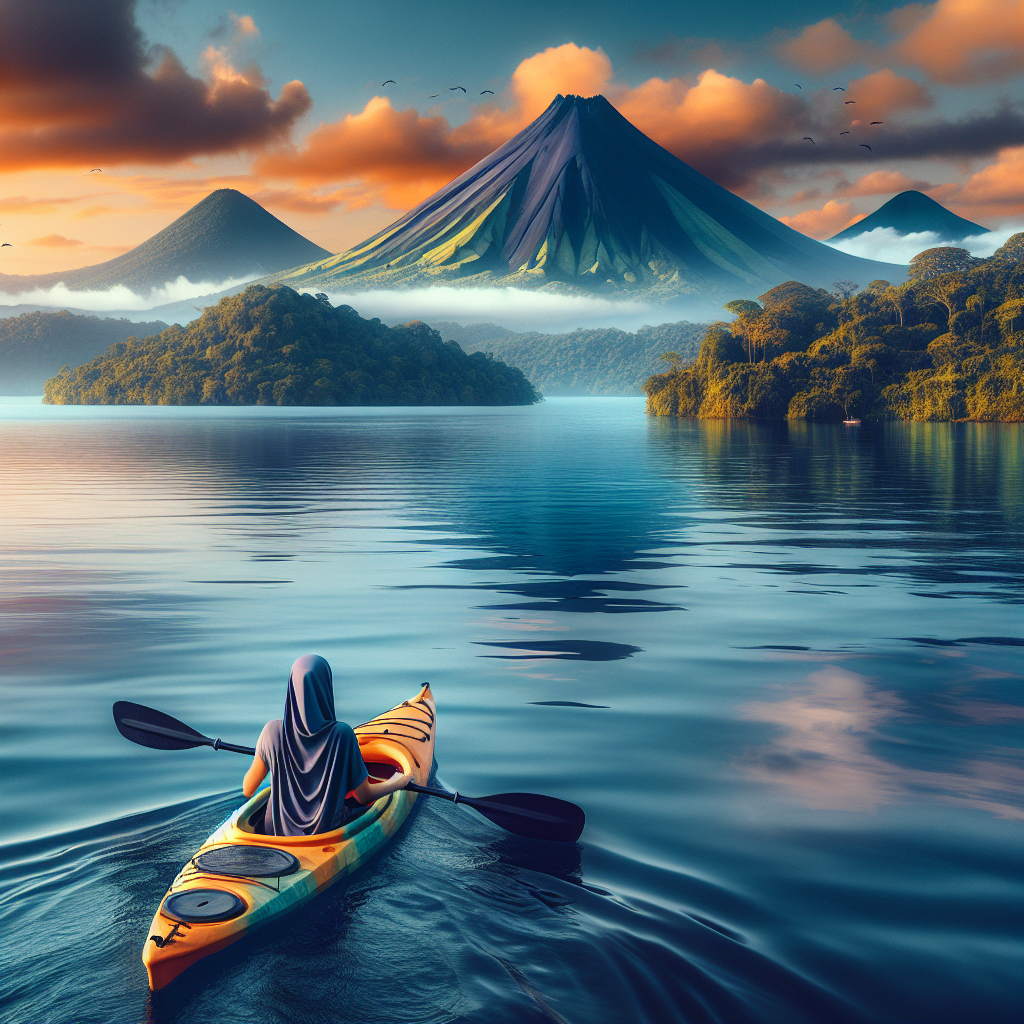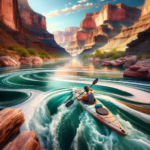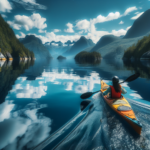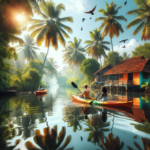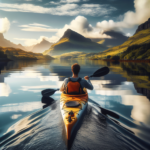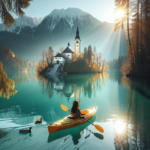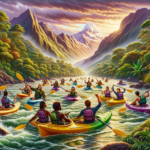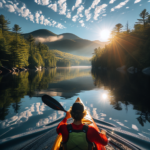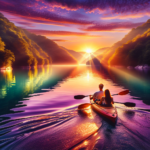Kayaking in Lake Nicaragua, Nicaragua
Introduction to Kayaking
Kayaking is a popular outdoor activity that offers a unique blend of adventure, exercise, and a close connection with nature. Whether you’re paddling through serene lakes, navigating winding rivers, or tackling the waves of the sea, kayaking provides an exhilarating experience that appeals to both beginners and seasoned adventurers. The sport has grown in popularity over the years, attracting enthusiasts who seek the thrill of exploring new waters and the tranquility of being surrounded by natural beauty.
In this article, we will spotlight the unique features of kayaking in Lake Nicaragua, Nicaragua, a destination that stands out for its stunning landscapes and rich biodiversity. We’ll delve into the specifics of what makes this location a fantastic choice for kayaking enthusiasts, from its geographical features to the best times to visit. Whether you’re planning your first kayaking trip or looking for a new adventure, Lake Nicaragua offers something for everyone.
Kayaking in Lake Nicaragua is not just about the physical activity; it’s also about immersing yourself in the local culture and history. The lake has a deep connection to the region’s heritage, and kayaking here allows you to experience this firsthand. From the local wildlife to the historical landmarks, every paddle stroke brings you closer to understanding the essence of Nicaragua.
What makes kayaking in Lake Nicaragua truly unique is the combination of its vast expanse, diverse ecosystems, and the presence of the iconic Ometepe Island. This island, formed by two volcanoes, offers a dramatic backdrop that enhances the kayaking experience. Whether you’re gliding over calm waters or exploring hidden coves, Lake Nicaragua promises an unforgettable adventure.
Overview of Kayaking in Lake Nicaragua, Nicaragua
Lake Nicaragua, also known as Cocibolca, is the largest lake in Central America and the 19th largest in the world. Its vast expanse covers over 8,000 square kilometers, providing ample space for kayaking adventures. The lake’s geography is diverse, featuring everything from open waters to secluded bays and inlets. The climate is tropical, with a wet season from May to October and a dry season from November to April, making it accessible year-round.
Historically, Lake Nicaragua has been a vital part of the region’s culture and economy. It was once considered as a potential route for the Panama Canal due to its size and strategic location. Today, it remains a hub for water sports and tourism, attracting visitors from around the world. The local communities have embraced kayaking as a way to showcase the natural beauty of the lake and promote sustainable tourism.
Accessing Lake Nicaragua is relatively straightforward. The nearest major city is Granada, which is well-connected by road and offers various transportation options to the lake. From Granada, you can easily reach popular kayaking spots by car or boat. The best times to visit are during the dry season when the weather is more predictable, and the waters are calmer.
One of the standout features of kayaking in Lake Nicaragua is the opportunity to explore Ometepe Island. This island, formed by the Concepción and Maderas volcanoes, is a UNESCO Biosphere Reserve and offers a unique blend of natural beauty and cultural heritage. Kayaking around Ometepe provides stunning views of the volcanoes, lush forests, and diverse wildlife, making it a must-visit destination for any kayaking enthusiast.
Kayaking Conditions in Lake Nicaragua, Nicaragua
Lake Nicaragua offers a variety of water conditions that cater to different kayaking preferences. The lake’s vast size means that you can find both calm, sheltered areas and more challenging open waters. The water is generally warm year-round, making it comfortable for extended kayaking trips. However, it’s essential to be aware of the weather conditions, as the lake can become choppy during storms.
The typical weather conditions in Lake Nicaragua vary depending on the season. During the dry season, from November to April, the weather is generally sunny and dry, with calm waters that are ideal for kayaking. The wet season, from May to October, brings more rain and occasional storms, which can create rougher water conditions. It’s crucial to check the weather forecast before heading out to ensure a safe and enjoyable experience.
Tides and water currents in Lake Nicaragua are relatively mild compared to coastal areas. However, the lake’s size means that wind can play a significant role in water conditions. On windy days, the open waters can become choppy, making it more challenging for kayakers. It’s advisable to stick to sheltered areas or plan your trip during calmer weather to avoid any difficulties.
Environmental factors such as water quality and visibility are generally good in Lake Nicaragua. The lake is home to a variety of fish species and other aquatic life, making it an excellent spot for wildlife enthusiasts. However, it’s essential to be mindful of local conservation efforts and practice eco-friendly kayaking to help preserve the lake’s natural beauty and biodiversity.
Top Spots for Kayaking in Lake Nicaragua, Nicaragua
One of the top spots for kayaking in Lake Nicaragua is Ometepe Island. This island offers a unique combination of natural beauty and cultural heritage, with its two volcanoes providing a stunning backdrop for your kayaking adventure. The waters around Ometepe are generally calm, making it suitable for kayakers of all skill levels. The best time to kayak here is during the early morning or late afternoon when the weather is cooler, and the light is perfect for photography.
Another popular spot is the Islets of Granada, a group of over 300 small islands located near the city of Granada. These islets are a kayaker’s paradise, offering calm waters, lush vegetation, and abundant wildlife. You can paddle through narrow channels, explore hidden coves, and even visit some of the inhabited islands to experience local culture. The best time to visit is during the dry season when the weather is more predictable.
For those seeking a more challenging experience, the open waters of Lake Nicaragua offer plenty of opportunities. The area around San Carlos, where the lake meets the San Juan River, is known for its strong currents and larger waves. This spot is ideal for experienced kayakers looking for an adrenaline rush. The best time to tackle these waters is during the dry season when the weather is more stable.
Lastly, the Solentiname Archipelago, located in the southern part of the lake, is another must-visit destination for kayakers. This group of islands is known for its artistic community and stunning natural beauty. Kayaking here allows you to explore pristine waters, visit local art galleries, and enjoy the tranquility of this remote area. The best time to visit is during the dry season when the weather is more favorable for kayaking.
Safety and Regulations
Safety is paramount when kayaking in Lake Nicaragua. Local regulations require all kayakers to wear life jackets at all times while on the water. It’s also recommended to carry a whistle or other signaling device in case of emergencies. Before heading out, make sure to inform someone of your plans and expected return time, especially if you’re kayaking alone or in remote areas.
In addition to wearing a life jacket, it’s essential to have the right safety gear and equipment. This includes a first aid kit, a waterproof map or GPS device, and a dry bag to keep your belongings safe. If you’re planning a longer trip, consider bringing extra food, water, and a means of communication, such as a mobile phone or VHF radio. Being prepared can make a significant difference in case of an emergency.
Understanding how to handle emergency situations is crucial for a safe kayaking experience. If you capsize, stay calm and try to re-enter your kayak as quickly as possible. If you’re unable to do so, stay with your kayak and signal for help. In case of severe weather, head to the nearest shore and seek shelter until conditions improve. Always be aware of your surroundings and know the location of the nearest safe landing spots.
Local authorities and tour operators often provide safety briefings and guidelines for kayaking in Lake Nicaragua. It’s a good idea to take advantage of these resources, especially if you’re unfamiliar with the area. Following local regulations and guidelines not only ensures your safety but also helps protect the environment and preserve the natural beauty of the lake for future generations.
Amenities and Accommodations
Lake Nicaragua offers a range of amenities to make your kayaking experience enjoyable and convenient. Several rental facilities around the lake provide kayaks, paddles, life jackets, and other necessary equipment. These facilities often offer guided tours, which can be an excellent option for those new to the area or looking to learn more about the local environment and culture.
When it comes to accommodations, there are plenty of options to suit different preferences and budgets. For those who enjoy camping, there are several campsites around the lake, including on Ometepe Island and the Islets of Granada. These sites offer basic amenities such as restrooms and picnic areas, allowing you to immerse yourself in nature while staying close to your kayaking spots.
If you prefer more comfort, there are numerous hotels and lodges around Lake Nicaragua. In Granada, you’ll find a range of accommodations from budget-friendly hostels to luxury hotels. Ometepe Island also offers various lodging options, including eco-lodges and boutique hotels that provide stunning views of the volcanoes and easy access to kayaking spots. Booking in advance is recommended, especially during peak tourist seasons.
In addition to kayaking, Lake Nicaragua offers a variety of recreational activities for visitors. You can explore hiking trails, visit local markets, or take part in cultural tours to learn more about the region’s history and traditions. Many tour operators offer combined packages that include kayaking and other activities, allowing you to make the most of your visit to this beautiful destination.
Environmental Considerations
Preserving the natural habitats and wildlife of Lake Nicaragua is crucial for maintaining its beauty and biodiversity. As a kayaker, you can play a significant role in conservation efforts by practicing eco-friendly kayaking. This includes avoiding littering, respecting wildlife, and staying on designated paths to minimize your impact on the environment. Always carry out what you carry in and dispose of waste properly.
One of the key guidelines for eco-friendly kayaking is to avoid disturbing wildlife. Lake Nicaragua is home to a variety of bird species, fish, and other aquatic life. Keep a safe distance from animals and avoid making loud noises that could startle them. If you encounter nesting birds or other sensitive wildlife areas, paddle quietly and give them plenty of space to avoid causing stress or disruption.
Supporting local conservation efforts is another way to contribute to the preservation of Lake Nicaragua. Many organizations and community groups are working to protect the lake’s ecosystems and promote sustainable tourism. Consider participating in local conservation projects or making a donation to support these initiatives. Your contribution can help ensure that future generations can enjoy the natural beauty of Lake Nicaragua.
Finally, be mindful of your use of resources while kayaking. Use biodegradable sunscreen and insect repellent to minimize your impact on the water quality. If you’re camping, use eco-friendly camping gear and follow Leave No Trace principles. By taking these small steps, you can help protect the environment and ensure that Lake Nicaragua remains a pristine destination for kayaking enthusiasts.
Highlights
When comparing kayaking in Lake Nicaragua to other popular kayaking destinations, several unique features stand out. One of the most notable is the lake’s biodiversity. Lake Nicaragua is home to a variety of fish species, including the rare freshwater bull shark. The surrounding areas also support diverse birdlife and other wildlife, making it a paradise for nature enthusiasts.
Geographically, Lake Nicaragua offers a unique combination of open waters and sheltered areas, providing a range of kayaking experiences. The presence of Ometepe Island, with its twin volcanoes, adds a dramatic and picturesque element that is hard to find elsewhere. The island’s rich cultural heritage and natural beauty make it a standout destination for kayakers looking for more than just a paddling adventure.
Historically, Lake Nicaragua has played a significant role in the region’s development. Its strategic location made it a key transportation route in the past, and today it remains an important cultural and economic hub. Kayaking here allows you to connect with this history and gain a deeper understanding of the region’s heritage. The local communities’ embrace of sustainable tourism also sets Lake Nicaragua apart as a model for eco-friendly travel.
Data-driven analysis shows that Lake Nicaragua offers excellent conditions for kayaking year-round, with favorable weather during the dry season and a variety of water conditions to suit different skill levels. The availability of amenities, guided tours, and diverse accommodation options further enhance its appeal as a top kayaking destination. Whether you’re a beginner or an experienced kayaker, Lake Nicaragua provides a unique and rewarding experience.
FAQ Section
- What is the best season to go kayaking in Lake Nicaragua? The best season is during the dry season, from November to April, when the weather is more predictable and the waters are calmer.
- Are there beginner-friendly spots for kayaking? Yes, areas like the Islets of Granada and the waters around Ometepe Island are suitable for beginners due to their calm conditions.
- What should I bring for a kayaking trip? Essential items include a life jacket, paddle, first aid kit, waterproof map or GPS, dry bag, sunscreen, insect repellent, and plenty of water and snacks.
- Are kayak rentals available? Yes, several rental facilities around the lake offer kayaks, paddles, life jackets, and other necessary equipment. Prices vary depending on the duration and type of kayak.
- How can I participate in local conservation efforts? You can support local conservation projects by making donations, participating in volunteer programs, and practicing eco-friendly kayaking.
- Are guided kayaking tours available? Yes, many tour operators offer guided kayaking tours that cover popular spots and provide insights into the local environment and culture.
- What safety measures are in place? Local regulations require wearing life jackets at all times. It’s also recommended to carry a whistle, first aid kit, and means of communication. Inform someone of your plans before heading out.
Final Thoughts
Kayaking in Lake Nicaragua is a premier destination for kayaking enthusiasts, offering a unique blend of natural beauty, cultural heritage, and diverse ecosystems. The lake’s vast expanse and varied water conditions cater to all skill levels, making it an ideal spot for both beginners and experienced kayakers. The presence of Ometepe Island and other scenic locations adds to the allure, providing unforgettable experiences.
As you plan your kayaking adventure, remember to respect local guidelines and conservation efforts. Practicing eco-friendly kayaking and supporting local conservation projects helps preserve the natural beauty of Lake Nicaragua for future generations. By being mindful of your impact, you can enjoy a rewarding and sustainable kayaking experience.
In conclusion, Lake Nicaragua offers a unique and captivating destination for kayaking enthusiasts. From its stunning landscapes and rich biodiversity to its cultural significance and welcoming communities, there’s something for everyone to enjoy. So pack your gear, plan your trip, and get ready to explore the beauty and thrill of kayaking in Lake Nicaragua, Nicaragua.

